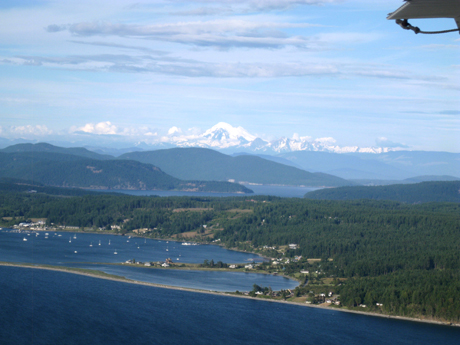The islands… national monuments?
Posted February 19, 2010 at 10:42 am by Ian Byington

This is why we're on the list...this is a photo of Mount Baker, looking past Lopez Island that I took from the air...beautiful place we live, eh?
Looks like the President has the San Juan Islands on a list of proposed national monuments. This is a big deal – here’s more, from the New West Communiy Blogs.
You can support the San Juan Update by doing business with our loyal advertisers, and by making a one-time contribution or a recurring donation.
Categories: Enviro Corner
One comment:










One comment...
The San Juan County (San Juan Islands) has two national parks and numerous state parks within it’s borders. I question how giving National Monumont status to the San Juan Islands would effect our county and our lives here. Would it mean more federal governmental control? Would it make it even more expensive to live here? How would it protect both the environment and the lifestyle of those who live here? My understanding from what I read below is that we have little to say in whether we want this status or not. And we definitely don’t have any say in how it would effect us if it happened. I want to trust and believe that this would be a good thing, but I am hesitent to embrace it. Is it just about receiving more federal monies to protect the orcas and other marine life? or does it mean more federal control over our personal property and our lifes? If anyone has any good answers please reply.
Quoting from Wikepedia on what is a National Monumont:
A National Monument in the United States is a protected area that is similar to a National Park except that the President of the United States can quickly declare an area of the United States to be a National Monument without the approval of Congress. National monuments receive less funding and afford fewer protections to wildlife than national parks. However areas within and extending beyond national parks, monuments, and national forests can be part of wilderness areas, which have an even greater degree of protection than a national park would alone, although wilderness areas managed by the US Forest Service and Bureau of Land Management often allow hunting.
National monuments can be managed by one of several federal agencies; the National Park Service, US Forest Service, United States Fish and Wildlife Service or by the Bureau of Land Management.
The power to grant national monuments comes from the Antiquities Act of 1906. President Theodore Roosevelt used the act to declare Devils Tower in Wyoming as the first national monument. He thought Congress was moving too slowly and it would be ruined by the time they made it a national park.
The Antiquities Act of 1906 resulted from concerns about protecting mostly prehistoric Native American ruins and artifacts — collectively termed “antiquities” — on federal lands in the West. It authorized permits for legitimate archaeological investigations and penalties for persons taking or destroying antiquities without permission. And it authorized presidents to proclaim “historic landmarks, historic and prehistoric structures, and other objects of historic or scientific interest” as national monuments — “the limits of which in all cases shall be confined to the smallest area compatible with the proper care and management of the objects to be protected.”
So it was originally expected that national monuments would be proclaimed to protect prehistoric cultural features or antiquities and that they would be small. Yet the reference in the act to “objects of … scientific interest” enabled President Theodore Roosevelt to make a natural geological feature, Devils Tower, Wyoming the first national monument three months later. Among the next three monuments he proclaimed in 1906 was Petrified Forest in Arizona, another natural feature (Congress would later make it into a national park).
The expectation that national monuments would be small was also soon overcome. In 1908 Roosevelt again used the act to proclaim more than 800,000 acres (3,200 km²) of the Grand Canyon as a national monument — a very big “object of scientific interest.” And in 1918 President Woodrow Wilson proclaimed Katmai National Monument in Alaska, comprising more than a million acres (4,000 km²). Katmai was later enlarged to nearly 2.8 million acres (11,000 km²) by subsequent Antiquities Act proclamations and for many years was the largest national park system unit. Petrified Forest, Grand Canyon, and Katmai were among the many national monuments later converted to national parks by Congress.
By submitting a comment you grant the San Juan Update a perpetual license to reproduce your words and name/web site in attribution. Inappropriate, irrelevant and contentious comments may not be published at an admin's discretion. Your email is used for verification purposes only, it will never be shared.